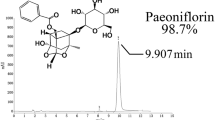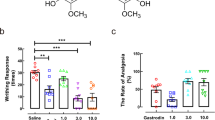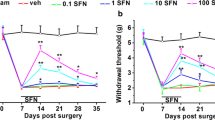Abstract
Neuropathic pain is one of the most common conditions requiring treatment worldwide. Salidroside (SAL), a phenylpropanoid glucoside extracted from Rhodiola, has been suggested to produce an analgesic effect in chronic pain. However, whether SAL could alleviate pain hypersensitivity after peripheral nerve injury and its mode of action remains unclear. Several studies suggest that activation of the spinal NOD-like receptor protein 3 (NLRP3) inflammasome and its related proteins contribute to neuropathic pain’s pathogenesis. This study investigates the time course of activation of spinal NLRP3 inflammasome axis in the development of neuropathic pain and also whether SAL could be an effective treatment for this type of pain by modulating NLRP3 inflammasome. In the chronic constriction injury (CCI) mice model, spinal NLRP3 inflammasome-related proteins and TXNIP, the mediator of NLRP3, were upregulated from the 14th to the 28th day after injury. The TXNIP and NLRP3 inflammasome-related proteins were mainly present in neurons and microglial cells in the spinal dorsal horn after CCI. Intraperitoneal injection of SAL at 200 mg/kg for 14 consecutive days starting from the 7th day of CCI injury could ameliorate mechanical and thermal hypersensitivity in the CCI model. Moreover, SAL inhibited the activation of the TXNIP/NLRP3 inflammasome axis and mitigated the neuronal loss of spinal dorsal horn induced by nerve injury. These results indicate that SAL could produce analgesic and neuroprotective effects in the CCI model of neuropathic pain.






Similar content being viewed by others
Data Availability
The datasets generated for this study are available on request to the corresponding author.
References
Campbell JN, Meyer RA (2006) Mechanisms of neuropathic pain. Neuron 52(1):77–92
Ji RR, Chamessian A, Zhang YQ (2016) Pain regulation by non-neuronal cells and inflammation. Science 354(6312):572–577
Starobova H, Nadar EI, Vetter I (2020) The NLRP3 inflammasome: role and therapeutic potential in pain treatment. Front Physiol 11:1016
Lamkanfi M, Dixit VM (2014) Mechanisms and functions of inflammasomes. Cell 157(5):1013–1022
Nakahira K et al (2011) Autophagy proteins regulate innate immune responses by inhibiting the release of mitochondrial DNA mediated by the NALP3 inflammasome. Nat Immunol 12(3):222–230
Zhou R et al (2010) Thioredoxin-interacting protein links oxidative stress to inflammasome activation. Nat Immunol 11(2):136–140
Choe JY, Kim SK (2017) Quercetin and ascorbic acid suppress fructose-induced NLRP3 inflammasome activation by blocking intracellular shuttling of TXNIP in human macrophage cell lines. Inflammation 40(3):980–994
Butler DSC et al (2018) Neuroepithelial control of mucosal inflammation in acute cystitis. Sci Rep 8(1):11015
Chen SP et al (2019) Pharmacological inhibition of the NLRP3 in flammasome as a potential target for cancer-induced bone pain. Pharmacol Res 147:104339
Son S et al (2019) Chemotherapeutic agent paclitaxel mediates priming of NLRP3 inflammasome activation. Front Immunol 10:1108
Deuis JR et al (2017) Role of the NLRP3 inflammasome in a model of acute burn-induced pain. Burns 43(2):304–309
Cowie AM et al (2019) NOD-like receptor protein 3 inflammasome drives postoperative mechanical pain in a sex-dependent manner. Pain 160(8):1794–1816
He W et al (2019) Microglial NLRP3 inflammasome activation mediates IL-1beta release and contributes to central sensitization in a recurrent nitroglycerin-induced migraine model. J Neuroinflammation 16(1):78
Khan N et al (2018) Pharmacological inhibition of the NLRP3 inflammasome as a potential target for multiple sclerosis induced central neuropathic pain. Inflammopharmacology 26(1):77–86
Pan Z et al (2018) miRNA-23a/CXCR4 regulates neuropathic pain via directly targeting TXNIP/NLRP3 inflammasome axis. J Neuroinflammation 15(1):29
Tonkin RS et al (2018) Attenuation of mechanical pain hypersensitivity by treatment with Peptide5, a connexin-43 mimetic peptide, involves inhibition of NLRP3 inflammasome in nerve-injured mice. Exp Neurol 300:1–12
Sagulenko V et al (2013) AIM2 and NLRP3 inflammasomes activate both apoptotic and pyroptotic death pathways via ASC. Cell Death Differ 20(9):1149–1160
Liao ZL et al (2019) Salidroside protects PC-12 cells against amyloid beta-induced apoptosis by activation of the ERK1/2 and AKT signaling pathways. Int J Mol Med 43(4):1769–1777
Wang H et al (2020) Neuroprotective effects of salidroside in a mouse model of Alzheimer’s disease. Cell Mol Neurobiol 40(7):1133–1142
Zhang X et al (2020) Salidroside ameliorates Parkinson’s disease by inhibiting NLRP3-dependent pyroptosis. Aging (Albany NY) 12(10):9405–9426
Li R, Chen J (2019) Salidroside protects dopaminergic neurons by enhancing PINK1/Parkin-mediated mitophagy. Oxid Med Cell Longev 2019:9341018
Zhong ZF et al (2019) Neuroprotective effects of salidroside on cerebral ischemia/reperfusion-induced behavioral impairment involves the dopaminergic system. Front Pharmacol 10:1433
Li S et al (2020) Fibroblast growth factor 2 contributes to the effect of salidroside on dendritic and synaptic plasticity after cerebral ischemia/reperfusion injury. Aging (Albany NY) 12(11):10951–10968
Kallscheuer N et al (2019) Identification and microbial production of the raspberry phenol salidroside that is active against Huntington’s disease. Plant Physiol 179(3):969–985
Vasileva LV et al (2018) Antidepressant-like effect of salidroside and curcumin on the immunoreactivity of rats subjected to a chronic mild stress model. Food Chem Toxicol 121:604–611
Ni GL et al (2017) Salidroside ameliorates diabetic neuropathic pain in rats by inhibiting neuroinflammation. J Mol Neurosci 63(1):9–16
Bennett GJ, Xie YK (1988) A peripheral mononeuropathy in rat that produces disorders of pain sensation like those seen in man. Pain 33(1):87–107
Fischer R et al (2019) TNFR2 promotes Treg-mediated recovery from neuropathic pain across sexes. Proc Natl Acad Sci USA 116(34):17045–17050
Chaplan SR et al (1994) Quantitative assessment of tactile allodynia in the rat paw. J Neurosci Methods 53(1):55–63
Hargreaves K et al (1988) A new and sensitive method for measuring thermal nociception in cutaneous hyperalgesia. Pain 32(1):77–88
Türeyen K et al (2004) Infarct volume quantification in mouse focal cerebral ischemia: a comparison of triphenyltetrazolium chloride and cresyl violet staining techniques. J Neurosci Methods 139(2):203–207
Ikenari T et al (2020) Evaluation of fluoro-jade C staining: specificity and application to damaged immature neuronal cells in the normal and injured mouse brain. Neuroscience 425:146–156
Zhong Z et al (2018) Pharmacological activities, mechanisms of action, and safety of salidroside in the central nervous system. Drug Des Dev Ther 12:1479–1489
Giordano C et al (2012) TRPV1-dependent and -independent alterations in the limbic cortex of neuropathic mice: impact on glial caspases and pain perception. Cereb Cortex 22(11):2495–2518
Grace PM et al (2016) Morphine paradoxically prolongs neuropathic pain in rats by amplifying spinal NLRP3 inflammasome activation. Proc Natl Acad Sci USA 113(24):E3441–E3450
Zendedel A et al (2016) Activation and regulation of NLRP3 inflammasome by intrathecal application of SDF-1a in a spinal cord injury model. Mol Neurobiol 53(5):3063–3075
Zheng T et al (2018) Salidroside attenuates high-fat diet-induced nonalcoholic fatty liver disease via AMPK-dependent TXNIP/NLRP3 pathway. Oxid Med Cell Longev 2018:8597897
Funding
This work was supported by National Natural Science Foundation of China (Grant No. 81971037 to F. Yang) the Beijing Natural Science Foundation Program and Scientific Research Key Program of Beijing Municipal Commission of Education (KZ201910025026 to F. Yang) and Support Project of High-level Teachers in Beijing Municipal Universities in the Period of 13th Five–year Plan CIT&TCD201904092 (QL).
Author information
Authors and Affiliations
Contributions
FY and TH designed the overall approach, coordinated the study, and drafted the manuscript. TH, QL, and FY prepared the manuscript. TH did most of the behavioral, Western blot and immunostaining studies and statistical analysis of the data. QS, YG, YZ, YD, YM, JL, WC and TL contributed to the design of the different experiments and executed a number of them. PW provided critical analysis of the experiments and the results. All authors read and approved the final manuscript.
Corresponding author
Ethics declarations
Conflict of interest
The authors declare that the research was conducted in the absence of any commercial or financial relationships that could be construed as a potential conflict of interest.
Ethical Approval
The animal study was reviewed and approved by the Capital Medical University Animal Care and Use Committee.
Additional information
Publisher's Note
Springer Nature remains neutral with regard to jurisdictional claims in published maps and institutional affiliations.
Rights and permissions
About this article
Cite this article
Hu, T., Sun, Q., Gou, Y. et al. Salidroside Alleviates Chronic Constriction Injury-Induced Neuropathic Pain and Inhibits of TXNIP/NLRP3 Pathway. Neurochem Res 47, 493–502 (2022). https://doi.org/10.1007/s11064-021-03459-y
Received:
Revised:
Accepted:
Published:
Issue Date:
DOI: https://doi.org/10.1007/s11064-021-03459-y




